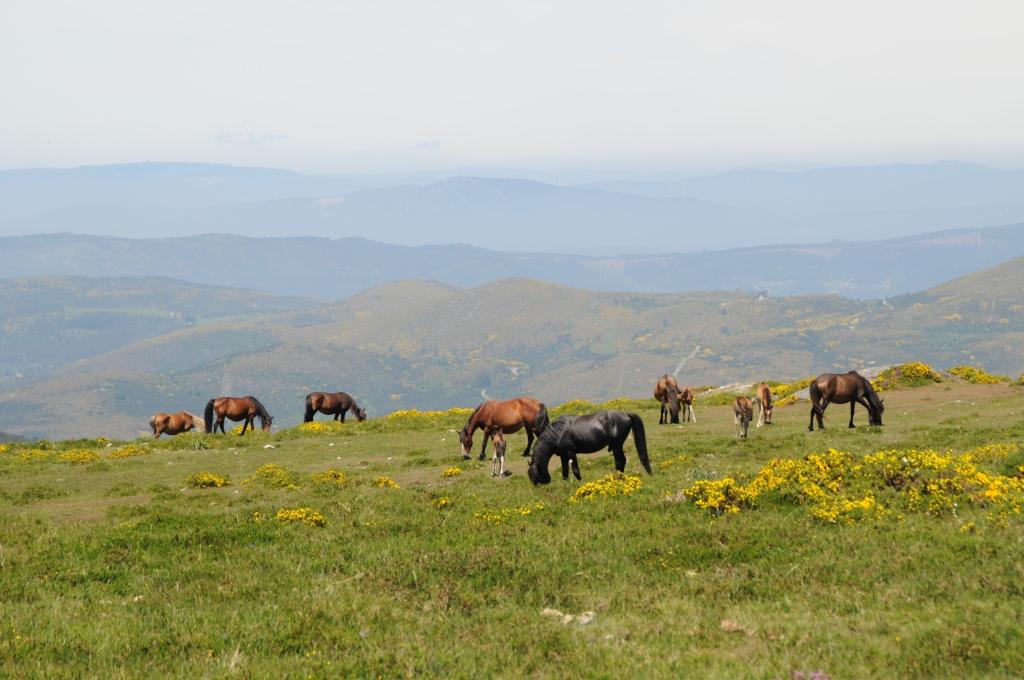This entry was contributed to Wild Equus by Dr. Jason Ransom of Colorado State University, member and specialist of the Wild Equus Network (WEN).
Species: Equus caballus Subspecies/Breed/Type: American Mustang
Estimated Population size: between 80–200 horses
Country: United States
Region/Province/Range: Colorado
Population type: Free-ranging-heavily managed
Management Authority: Government Agency – Bureau of Land Management (BLM)
Images from Jason Ransom
Details of Home Range or Territory
The Little Book Cliffs Wild Horse Range, located in Mesa County, Colorado, USA (latitude 39°12‘N, longitude 108°25‘W), consists of approximately 14,600 ha of sloping plateaus, sagebrush (Artemisia spp.) parks, and 4 major canyon systems. Elevations range from 1,500 m to 2,250 m, and the vegetation is characterized by dense stands of Colorado piñon (Pinus edulis) and Utah juniper (Juniperus osteosperma). Mean annual temperature is 11.5°C (range= -26.7– 41.1°C). Mean total annual precipitation is 235.4 mm (range=184.4–300.2 mm) and this typically falls in a monsoonal pattern of late summer rains. Pumas (Puma concolor) are present and do prey on foals, but rarely kill subadult and adult horses. Horses use all aspects of the geography, including travel routes shared with bighorn sheep (Ovis canadensis) on some nearly vertical cliff faces. Most horses tend to migrate to higher elevations in the summer and retreat into the canyons in winter. This area was protected for horses prior to the 1971 U.S. law that protected wild horses thanks to grassroots public interest. That interest remains today and citizens continue to monitor horses and collaborate with researchers and managers toward the stewardship of this herd.
Details of Population
The US Bureau of Land Management has managed this population with periodic round-ups, adopting removed horses to the public. Since 2003, management has more intensively been done using the immunocontraceptive PZP. Prior to PZP use, annual population growth exceeded 20% (in 2003), but between 2004-2011 when PZP was fully implemented, annual growth rate was reduced to an average of 7.6%, resulting in less frequent round-ups.
Structure and demographics
Population size ranges from 80–200 horses and is arranged into roughly 30 bands of 2–9 horses each. Bachelors form loosely associated ephemeral bands or range independently. Most females give birth within about a 4 week time period ranging from late April to late May.
Issues worth noting and needed actions
Like most populations in the USA, available habitat for horses is finite and management is necessary to protect all natural resources while attempting to balance the multiple-use mandate for the federal lands where horses live. The science needed for more-informed management is improving, but many obstacles persist. You can read much more in the 2013 National Research Council report “Using Science to Improve the BLM Wild Horse and Burro Program: A Way Forward” – a free PDF is available at http://www.nap.edu/catalog/13511/using-science-to-improve-the-blm-wild-horse-and-burro-program
Additional details about this population, and specifically about behavior and fertility control, can be found in:
Ransom, J.I., Roelle, J.E., Cade, B.S., Coates-Markle, L., and A.J. Kane. 2011. Foaling rates in feral horses treated with the immunocontraceptive porcine zona pellucida. Wildlife Society Bulletin 35:343-352
Ransom, J.I., Cade, B.S., and N.T. Hobbs. 2010. Influences of immunocontraception on time budgets, social behavior, and body condition in feral horses. Applied Animal Behaviour Science 124:51-60
Ransom, J.I., Hobbs, N.T., and J. Bruemmer. 2013. Contraception can lead to trophic asynchrony between birth pulse and resources. PLoS ONE 8:e54972
If you have further information or images you would like to share please contact us by email.
More entries to the Wild Equus Atlas;
Venezuelan Creoles WE – Entry from Dr. Jose Luis Canelon
Pottoka Piornal ponies WE – Entry from Lucy Ress
Pryor Mountain wild horses WE – Entry from Dr. Jason Ransom
McCullough Peaks horses – Entry from Dr. Jason Ransom
Aveto horses (WE) – Entry from Evelina Isola
Galician wild ponies WE – Entry from Dr. Laura Lagos
Namibia Desert horses WE – Entry from Dr. Telané Greyling
Delft Island horses WE – Entry from Wild Equus
Little Book Cliffs Wild Horses WE – Entry from Dr. Jason Ransom
Gower ponies WE – Entry from Jennie Nellist
Baguales WE – Entry from Dr. Victor Moraga and Enrique Zunzunegui
Exmoor Ponies WE – Entry from Sue McGeever
Tornquist feral horses WE – Entry from Dr. Alberto Scorolli
Sabucedo horses WE – Entry from Ivan Sanmartin Eirin
Cumberland Island horses WE – Entry from Wild Equus
Feral horses of Cotopaxi WE – Entry from Javier Solis Méndez, Lucy Rees, Johanna Marlès and Juan Bermeo
Please share this initiative far and wide. Gracias!
This is an ongoing work, and as such, will be updated regularly as new information is made available.













































